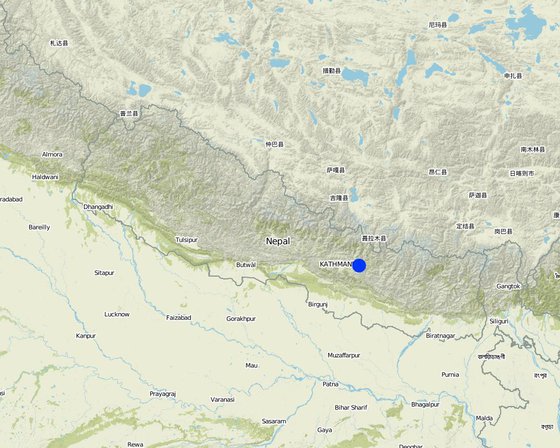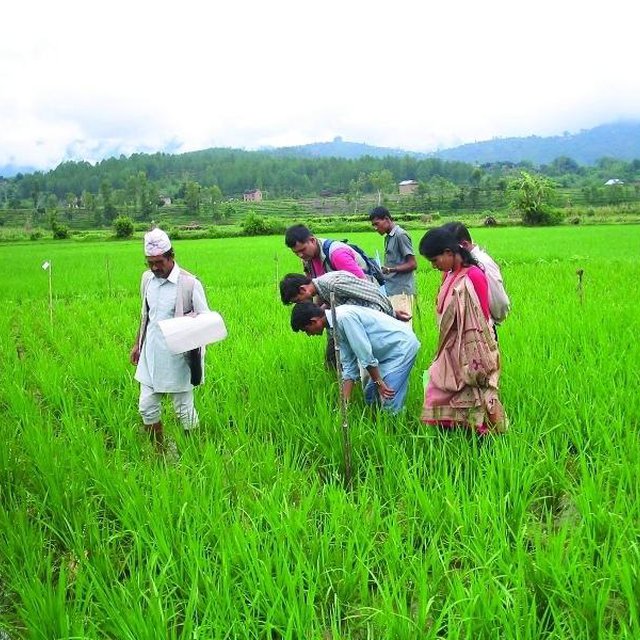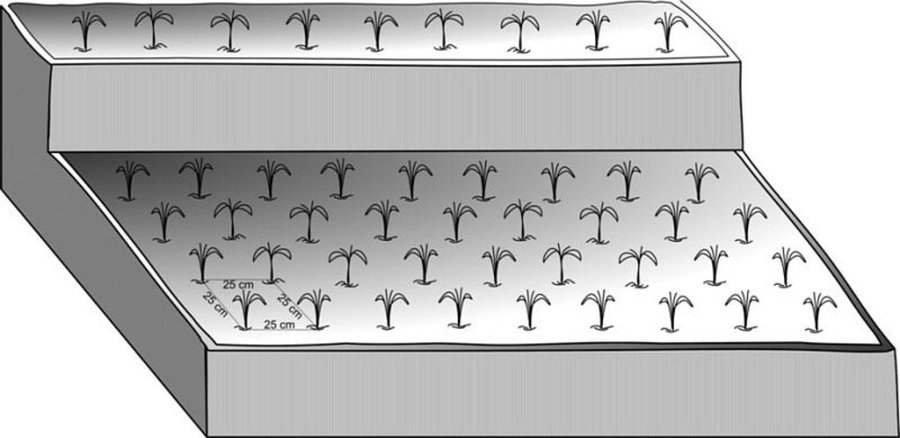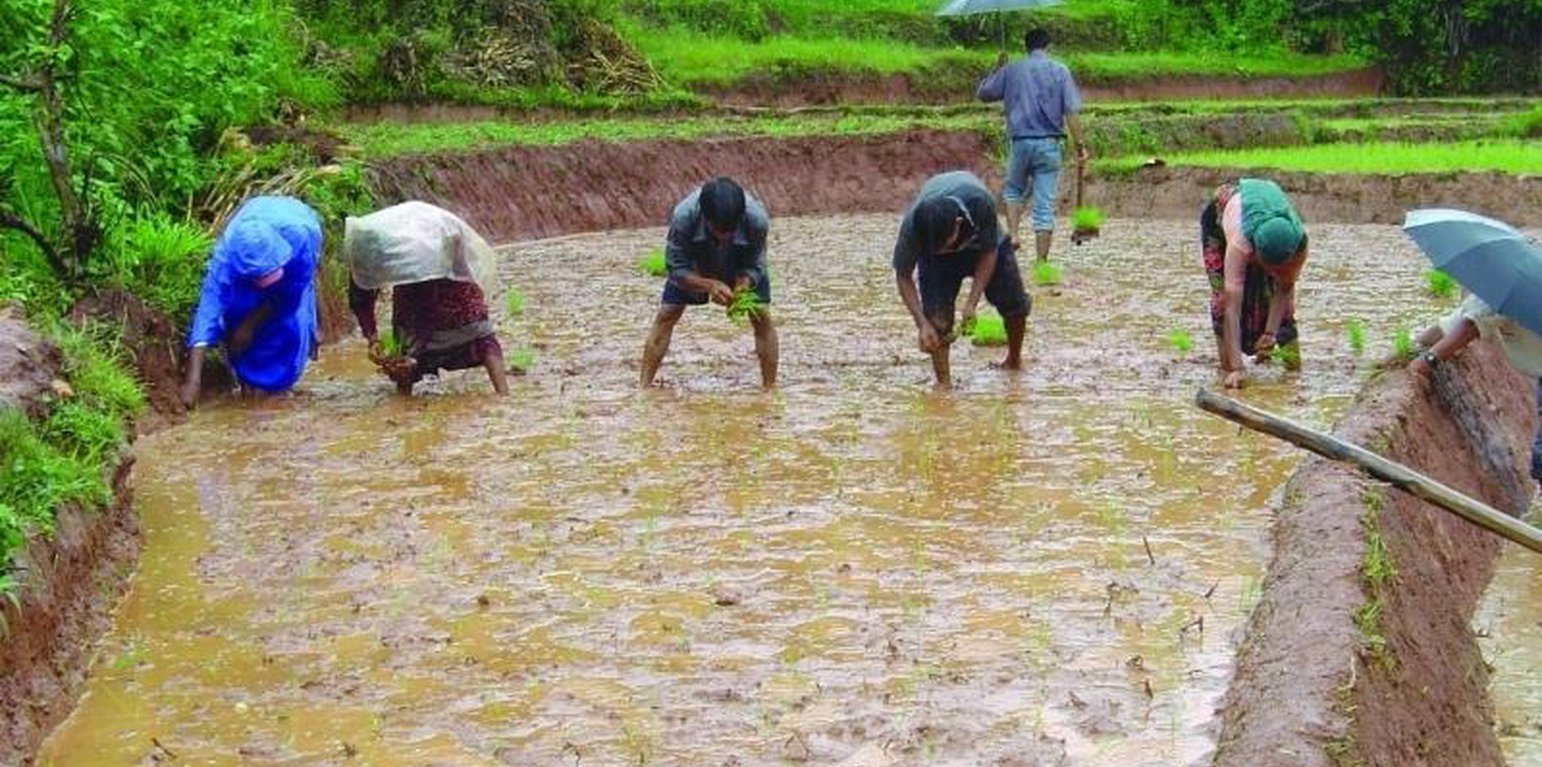System of Rice Intensification
(ເນໂປ)
Dhan uttapadan bridi garne tarika - Nepali
ຄຳອະທິບາຍ
A method for increasing the productivity of rice by changing the management of plants, soil, water, and nutrients.
The System of Rice Intensification (SRI) was developed in Madagascar by Henri de Laulanie, in the 1980s. He worked with Malagasy farmers and colleagues to improve the possibilities of rice production. The practice contributes to both healthier soil and healthier plants, supported by greater root growth and the nurturing of soil microbial abundance and diversity. It is based on a number of well-founded agro-ecological principles. SRI concepts and practices have also been successfully adapted to upland rice.
SRI involves transplanting very young rice seedlings (usually 8-12 days old with just two small leaves) carefully and quickly so as to cause minimum disturbance to the roots. The seedlings are planted individually, in contrast to the traditional method where clumps of 3-4 are planted together, minimising root competition between the seedlings. The seedlings are kept widely spaced to allow better root and canopy growth, in a square grid pattern at a spacing of at least 25 x 25 cm. Planting can be done even wider at 30 x 30 or 40 x 40 cm and even up to 50 x 50 cm in the best quality soils.
The soil is kept moist but well drained and aerated to support increased biological activity. A small quantity of water is applied during the vegetative growth period following which a thin layer of water is maintained on the fields only during the flowering and grain-filling stages. Better quality compost, such as well decomposed farmyard manure, can be applied to achieve additional yield increases. Since weed growth will be more abundant and will be a problem in fields that are not kept flooded (and because of the wider spacing), weeding needs to be done at least once or twice in the first 10-12 days and a total of three or four times altogether before the canopy closes.
SRI does not require additional inputs like new seeds, chemical fertiliser or pesticides, but it does require the skilful management of the factors in production and, at least initially, 25-50% more labour inputs, particularly for the transplanting and weeding. As farmers become more skilled and confident in SRI, the amount of labour needed decreases and can eventually become the same or even less than with conventional methods.
SRI is being tried out by farmers in many areas of Nepal’s middle mountains including in the Jhikhu Khola watershed. This area has an altitude of 800-2200 masl, and receives about 1200 mm annual rainfall, about 70-80% in the monsoon months (June to September).
ສະຖານທີ່

ສະຖານທີ່: Kavre palanchowk/Jhikhu Khola watershed, ເນໂປ
ຈໍານວນ ພື້ນທີ່ ທີ່ໃຊ້ ເຕັກໂນໂລຢີ ທີ່ໄດ້ວິເຄາະ:
ການຄັດເລືອກພື້ນທີ່ ທີ່ອີງໃສ່ຂໍ້ມູນທາງພູມີສາດ
ການແຜ່ກະຈາຍຂອງເຕັກໂນໂລຢີ: ແຜ່ຂະຫຍາຍຢ່າງໄວວາໃນພື້ນທີ່ (approx. < 0.1 ກິໂລແມັດ2 (10 ເຮັກຕາ))
ຢູ່ໃນເຂດປ່າສະຫງວນທີ່ບໍ?:
ວັນທີຂອງການປະຕິບັດ: ຕໍ່າກວ່າ 10 ປີ ຜ່ານມາ (ມາເຖິງປະຈຸບັນ)
ປະເພດຂອງການນໍາສະເໜີ
-
ໂດຍຜ່ານນະວັດຕະກໍາຄິດຄົ້ນຂອງຜູ້ນໍາໃຊ້ທີ່ດິນ
-
ເປັນສ່ວນໜື່ງຂອງລະບົບພື້ນເມືອງ (>50 ປີ)
-
ໃນໄລຍະການທົດລອງ / ການຄົ້ນຄວ້າ
-
ໂດຍຜ່ານໂຄງການ / ການຊ່ວຍເຫຼືອຈາກພາຍນອກ

-
ຈຸດປະສົງຕົ້ນຕໍ
-
ປັບປຸງ ການຜະລິດ
-
ຫຼຸດຜ່ອນ, ປ້ອງກັນ, ຟື້ນຟູ ການເຊື່ອມໂຊມຂອງດິນ
-
ການອະນຸລັກ ລະບົບນິເວດ
-
ປົກປັກຮັກສານໍ້າ / ນໍ້າພື້ນທີ່ - ປະສົມປະສານກັບ ເຕັກໂນໂລຢີອື່ນໆ
-
ປົກປັກຮັກສາ / ການປັບປຸງຊີວະນາໆພັນ
-
ຫຼຸດຜ່ອນຄວາມສ່ຽງ ທາງໄພພິບັດທໍາມະຊາດ
-
ປັບຕົວຕໍ່ກັບການປ່ຽນແປງດິນຟ້າອາກາດ / ທີ່ຮ້າຍແຮງ ແລະ ຜົນກະທົບ
-
ຫຼຸດຜ່ອນຜົນກະທົບ ຈາກການປ່ຽນແປງດິນຟ້າອາກາດ
-
ສ້າງຜົນກະທົບ ທາງເສດຖະກິດ ທີ່ເປັນປະໂຫຍດ
-
ສ້າງຜົນກະທົບ ທີ່ເປັນທາງບວກ ໃຫ້ແກ່ສັງຄົມ
ການນໍາໃຊ້ດິນ
-
ດິນທີ່ປູກພືດ
- ການປູກພືດປະຈໍາປີ: ທັນຍາພືດ-ສາລີ, ຜັກ-ອື່ນໆ, rice, wheat
ຈໍານວນ ລະດູການ ປູກໃນປີໜຶ່ງ: 3
ການສະໜອງນໍ້າ
-
ນໍ້າຝົນ
-
ປະສົມປະສານ ກັນລະຫວ່າງ ນໍ້າຝົນ ແລະ ນໍ້າຊົນລະປະທານ
-
ນໍາໃຊ້ ນໍ້າຊົນລະປະທານ ພຽງຢ່າງດຽວ
ຈຸດປະສົງທີ່ກ່ຽວຂ້ອງກັບການເຊື່ອມໂຊມຂອງດິນ
-
ປ້ອງກັນການເຊື່ອມໂຊມຂອງດິນ
-
ຫຼຸດຜ່ອນການເຊື່ອມໂຊມຂອງດິນ
-
ການຟື້ນຟູ / ຟື້ນຟູດິນທີ່ຊຸດໂຊມ
-
ປັບຕົວຕໍ່ການເຊື່ອມໂຊມຂອງດິນ
-
ບໍ່ສາມາດໃຊ້ໄດ້
ການເຊື່ອມໂຊມ ທີ່ຕ້ອງໄດ້ເອົາໃຈໃສ່
-
ການເຊື່ອມໂຊມ ຂອງດິນ ທາງເຄມີ - Cn: ຄວາມອຸດົມສົມບູນ ລົດໜ້ອຍຖອຍລົງ ແລະ ສານອິນຊີວັດຖຸລົດລົງ (ບໍ່ແມ່ນສາເຫດມາຈາກການເຊາະເຈື່ອນ)
ກຸ່ມການຄຸ້ມຄອງທີ່ດິນແບບຍືນຍົງ
ມາດຕະການ ການຄຸ້ມຄອງທີ່ດິນແບບຍືນຍົງ
-
ມາດຕະການ ທາງດ້ານການຄຸ້ມຄອງ - M2: ການປ່ຽນແປງ ການຈັດການຄຸ້ມຄອງ / ລະດັບຄວາມໜາແໜ້ນ
ເທັກນິກການແຕ້ມຮູບ
ຂໍກຳນົດທາງເທັກນິກ
In the SRI method young seedlings (8-12 days old) are planted singly at a wide spacing of 25 x 25 cm or more
Technical knowledge required for field staff / advisors: moderate
Technical knowledge required for land users: low
Main technical functions: improved plant management, improved soil management, improved water management
Secondary technical functions: increase in organic matter, increase in soil fertility
Change of land use practices / intensity level: Planting method, irrigation method and soil fertility management is carriedout differently compare to traditional method.

Author: Madhav Dhakal , A. K. Thaku
ການຈັດຕັ້ງ ແລະ ບໍາລຸງຮັກສາ: ກິດຈະກໍາ, ວັດຖຸດິບ ແລະ ຄ່າໃຊ້ຈ່າຍ
ການຄຳນວນ ປັດໃຈການຜະລິດ ແລະ ຄ່າໃຊ້ຈ່າຍ
- ຄິດໄລ່ຄ່າໃຊ້ຈ່າຍ: ຕໍ່ພື້ນທີ່ ທີ່ໄດ້ຈັດຕັ້ງປະຕິບັດ ເຕັກໂນໂລຢີ (ຂະໜາດ ແລະ ຫົວໜ່ວຍ ຂອງພື້ນທີ່:1 ha)
- ສະກຸນເງິນທີ່ໃຊ້ສໍາລັບການຄິດໄລ່ຄ່າໃຊ້ຈ່າຍ: USA
- ອັດຕາແລກປ່ຽນ (ເປັນເງີນ ໂດລາ): 1 USD = ບໍ່ມີຂໍ້ມູນ
- ຄ່າແຮງງານສະເລ່ຍ ຂອງການຈ້າງແຮງງານຕໍ່ມື້: 2.10
ປັດໄຈທີ່ສໍາຄັນສຸດທີ່ສົ່ງຜົນກະທົບຕໍ່ຄ່າໃຊ້ຈ່າຍ
Due to increased off-farm employment trend , there is lack of manpower for field operation, which increases the labour cost .
ກິດຈະກໍາການສ້າງຕັ້ງ
n.a.
ກິດຈະກໍາບໍາລຸງຮັກສາ
-
Application of fertilizer (ໄລຍະເວລາ / ຄວາມຖີ່: None)
-
Application of pesticides ( if required) (ໄລຍະເວລາ / ຄວາມຖີ່: None)
-
Transplantation (ໄລຍະເວລາ / ຄວາມຖີ່: monsoon, 8 to 12 days after seed sowing /)
-
Irrigation of the mainfield ( to keep fields alternately dry and moist) (ໄລຍະເວລາ / ຄວາມຖີ່: vegetative period / weekly after transplantation;)
-
Weeding (ໄລຍະເວລາ / ຄວາມຖີ່: vegetative period / 3-4 times; first within 10 day)
-
Harvesting (ໄລຍະເວລາ / ຄວາມຖີ່: October/November /)
-
Nursery bed preparation, seed treatment and sowing (ໄລຍະເວລາ / ຄວາມຖີ່: Beginning of monsoon /)
-
Main field preparation ( ploughing and leveling) (ໄລຍະເວລາ / ຄວາມຖີ່: Beginning of monsoon /)
ປັດໄຈນໍາເຂົ້າໃນການບໍາລຸງຮັກສາ ແລະ ຄ່າໃຊ້ຈ່າຍ (per 1 ha)
| ລະບຸ ປັດໃຈ ນໍາເຂົ້າ ໃນການຜະລີດ |
ຫົວໜ່ວຍ |
ປະລິມານ |
ຕົ້ນທຶນ ຕໍ່ຫົວໜ່ວຍ (USA) |
ຕົ້ນທຶນທັງໝົດ ຂອງປັດໃຈຂາເຂົ້າ ໃນການຜະລິດ (USA) |
% ຂອງຕົ້ນທຶນທັງໝົດ ທີ່ຜູ້ນໍາໃຊ້ທີ່ດິນ ໃຊ້ຈ່າຍເອງ |
|
ແຮງງານ
|
| Maintaining field |
Persons/day |
353.0 |
2.1 |
741.3 |
100.0 |
|
ອຸປະກອນ
|
| Machin use |
ha |
1.0 |
136.0 |
136.0 |
100.0 |
|
ວັດສະດຸໃນການປູກ
|
| Seeds |
ha |
1.0 |
4.0 |
4.0 |
100.0 |
|
ຝຸ່ນ ແລະ ຢາຊີວະພາບ
|
| Fertilizer |
ha |
1.0 |
94.0 |
94.0 |
100.0 |
| Biocoides |
ha |
1.0 |
56.0 |
56.0 |
100.0 |
| ຕົ້ນທຶນທັງໝົດ ທີ່ໃຊ້ໃນການບໍາລຸງຮັກສາ ເຕັກໂນໂລຢີ |
1'031.3 |
|
| ຄ່າໃຊ້ຈ່າຍທັງໝົດ ສຳລັບການບົວລະບັດຮກສາເຕັກໂນໂລຢີ ເປັນສະກຸນເງີນໂດລາ |
1'031.3 |
|
ສະພາບແວດລ້ອມທໍາມະຊາດ
ສະເລ່ຍປະລິມານນໍ້າຝົນປະຈໍາປີ
-
< 250 ມີລິແມັດ
-
251-500 ມີລິແມັດ
-
501-750 ມີລິແມັດ
-
751-1,000 ມີລິແມັດ
-
1,001-1,500 ມີລິແມັດ
-
1,501-2,000 ມີລິແມັດ
-
2,001-3,000 ມີລິແມັດ
-
3,001-4,000 ມີລິແມັດ
-
> 4,000 ມີລິແມັດ
ເຂດກະສິກໍາ-ສະພາບອາກາດ
-
ຄວາມຊຸ່ມ
-
ເຄີ່ງຄວາມຊຸ່ມ
-
ເຄິ່ງແຫ້ງແລ້ງ
-
ແຫ້ງແລ້ງ
ຂໍ້ມູນຈໍາເພາະກ່ຽວກັບສະພາບອາກາດ
ປະລິມານນໍ້າຝົນສະເລ່ຍຕໍ່ປີເປັນມິລິແມັດ: 1200.0
Thermal climate class: subtropics
ຄວາມຄ້ອຍຊັນ
-
ພື້ນທີ່ຮາບພຽງ (0-2%)
-
ອ່ອນ (3-5 %)
-
ປານກາງ (6-10 %)
-
ມ້ວນ (11-15 %)
-
ເນີນ(16-30%)
-
ໍຊັນ (31-60%)
-
ຊັນຫຼາຍ (>60%)
ຮູບແບບຂອງດິນ
-
ພູພຽງ / ທົ່ງພຽງ
-
ສັນພູ
-
ເປີ້ນພູ
-
ເນີນພູ
-
ຕີນພູ
-
ຮ່ອມພູ
ລະດັບຄວາມສູງ
-
0-100 ແມັດ a.s.l.
-
101-500 ແມັດ a.s.l.
-
501-1,000 ແມັດ a.s.l.
-
1,001-1,500 ແມັດ a.s.l.
-
1,501-2,000 ແມັດ a.s.l.
-
2,001-2,500 ແມັດ a.s.l.
-
2,501-3,000 ແມັດ a.s.l.
-
3,001-4,000 ແມັດ a.s.l.
-
> 4,000 ແມັດ a.s.l.
ເຕັກໂນໂລຢີໄດ້ຖືກນໍາໃຊ້ໃນ
-
ລັກສະນະສວດ
-
ລັກສະນະກີ່ວ
-
ບໍ່ກ່ຽວຂ້ອງ
ຄວາມເລິກຂອງດິນ
-
ຕື້ນຫຼາຍ (0-20 ຊັງຕີແມັດ)
-
ຕື້ນ (21-50 ຊຕມ)
-
ເລີກປານກາງ (51-80 ຊຕມ)
-
ເລິກ (81-120 ຊມ)
-
ເລິກຫຼາຍ (> 120 cm)
ໂຄງສ້າງຂອງດິນ (ເທີງໜ້າດິນ)
-
ຫຍາບ / ເບົາ (ດິນຊາຍ)
-
ປານກາງ (ດິນໜຽວ, ດິນໂຄນ)
-
ບາງລະອຽດ / ໜັກ (ໜຽວ)
ໂຄງສ້າງຂອງດິນ (ເລິກລົງ 20 ຊັງຕີແມັດ)
-
ຫຍາບ / ເບົາ (ດິນຊາຍ)
-
ປານກາງ (ດິນໜຽວ, ດິນໂຄນ)
-
ບາງລະອຽດ / ໜັກ (ໜຽວ)
ທາດອິນຊີຢູ່ເທິງໜ້າດິນ
-
ສູງ (> 3 %)
-
ປານກາງ (1-3 %)
-
ຕໍາ່ (<1 %)
ນ້ຳໃຕ້ດິນ
-
ເທິງຊັ້ນໜ້າດິນ
-
< 5 ແມັດ
-
5-50 ແມັດ
-
> 50 ແມັດ
ມີນໍ້າໜ້າດິນ
-
ເກີນ
-
ດີ
-
ປານກາງ
-
ທຸກຍາກ / ບໍ່ມີ
ຄຸນນະພາບນໍ້າ (ການຮັກສາ)
-
ມີນໍ້າດື່ມ
-
ບໍ່ມີນໍ້າດື່ມ (ຮຽກຮ້ອງໃຫ້ມີການບຳບັດນ້ຳ)
-
ນຳໃຊ້ເຂົ້າໃນການຜະລິດກະສິກໍາພຽງຢ່າງດຽງ (ຊົນລະປະທານ)
-
ຜິດປົກກະຕິ
ຄຸນນະພາບນ້ຳ ໝາຍເຖີງ:
ດິນເຄັມເປັນບັນຫາບໍ່?
ການເກີດນໍ້າຖ້ວມ
ຄວາມຫຼາກຫຼາຍຂອງສິ່ງທີ່ມີຊີວິດ
ຄຸນລັກສະນະຂອງຜູ້ນຳໃຊ້ທີ່ດິນການນໍາໃຊ້ເຕັກໂນໂລຢີ
ການວາງແນວທາງຕະຫຼາດ
-
ກຸ້ມຕົນເອງ (ພໍພຽງ)
-
ປະສົມປົນເປ( ກຸ້ມຕົນເອງ/ເປັນສິນຄ້າ)
-
ການຄ້າ / ຕະຫຼາດ
ລາຍຮັບທີ່ໄດ້ມາຈາກກິດຈະກໍາອື່ນໆ ທີ່ບໍ່ແມ່ນການຜະລິດກະສິກໍາ
-
ໜ້ອຍກ່ວາ 10 % ຂອງລາຍຮັບທັງໝົດ
-
10-50 % ຂອງລາຍຮັບທັງໝົດ
-
> 50 % ຂອງລາຍຮັບທັງໝົດ
ລະດັບຄວາມຮັ່ງມີ
-
ທຸກຍາກຫຼາຍ
-
ທຸກຍາກ
-
ສະເລ່ຍ
-
ຮັ່ງມີ
-
ຮັ່ງມີຫຼາຍ
ລະດັບຂອງການຫັນເປັນກົນຈັກ
-
ການໃຊ້ແຮງງານຄົນ
-
ສັດລາກແກ່
-
ເຄື່ອງກົນຈັກ
ຢູ່ປະຈຳ ຫຼື ເລລ້ອນ
-
ບໍ່ເຄື່ອນໄຫວ
-
ແບບເຄີ່ງຂັງ-ເຄີ່ງປ່ອຍ
-
ແບບປ່ອຍຕາມທຳມະຊາດ
ບຸກຄົນ ຫຼື ກຸ່ມ
-
ບຸກຄົນ / ຄົວເຮືອນ
-
ກຸ່ມ / ຊຸມຊົນ
-
ການຮ່ວມມື
-
ການຈ້າງງານ (ບໍລິສັດ, ອົງການ ລັດຖະບານ)
ອາຍຸ
-
ເດັກນ້ອຍ
-
ຊາວໜຸ່ມ
-
ໄວກາງຄົນ
-
ຜູ້ສູງອາຍຸ
ເຂດພື້ນທີ່ການນໍາໃຊ້ຕໍ່ຄົວເຮືອນ
-
<0.5 ເຮັກຕາ
-
0.5-1 ເຮັກຕາ
-
1-2 ເຮັກຕາ
-
2-5 ເຮັກຕາ
-
5-15 ເຮັກຕາ
-
15-50 ເຮັກຕາ
-
50-100 ເຮັກຕາ
-
100-500 ເຮັກຕາ
-
500-1,000 ເຮັກຕາ
-
1,000-10,000 ເຮັກຕາ
-
> 10,000 ເຮັກຕາ
ຂະໜາດ
-
ຂະໜາດນ້ອຍ
-
ຂະໜາດກາງ
-
ຂະໜາດໃຫຍ່
ເຈົ້າຂອງທີ່ດິນ
-
ລັດ
-
ບໍລິສັດ
-
ຊຸມຊົນ / ບ້ານ
-
ກຸ່ມ
-
ບຸກຄົນ, ບໍ່ມີຕໍາແໜ່ງ
-
ບຸກຄົນ, ທີ່ມີຕໍາແໜ່ງ
ສິດທິການນໍາໃຊ້ທີ່ດິນ
-
ເປີດກວ້າງ (ບໍ່ມີການຈັດຕັ້ງ)
-
ຊຸມຊົນ (ທີ່ມີການຈັດຕັ້ງ)
-
ເຊົ່າ
-
ບຸກຄົນ
ສິດທິການນໍາໃຊ້ນໍ້າ
-
ເປີດກວ້າງ (ບໍ່ມີການຈັດຕັ້ງ)
-
ຊຸມຊົນ (ທີ່ມີການຈັດຕັ້ງ)
-
ເຊົ່າ
-
ບຸກຄົນ
ການເຂົ້າເຖິງການບໍລິການ ແລະ ພື້ນຖານໂຄງລ່າງ
ຜົນກະທົບ
ຜົນກະທົບທາງສັງຄົມ ແລະ ເສດຖະກິດ
ຜົນຜະລິດ
10 - 57 percent grain yield increased
ການຜະລິດອາຫານສັດ
3 - 40 percent above ground bio -mass increased
ຄຸນນະພາບຂອງອາຫານສັດ
3 - 40 percent above ground bio -mass increased
ລາຍຮັບ ຈາກການຜະລີດ
due to increased grain and biomass; seed , fertilizer, and labour saving,
ມີວຽກໜັກ
only the first weeding is labour intensive
ຜົນກະທົບທາງສັງຄົມ ວັດທະນະທໍາ
ສະຖາບັນ ການຈັດຕັ້ງຊຸມຊົນ
planning, discussing in a group and implementing the method systematically
ຄວາມຮູ້ກ່ຽວກັບ ການຄຸ້ມຄອງ ທີ່ດິນແບບຍືນຍົງ / ການເຊື່ອມໂຊມຂອງດິນ
use of organic fertilizer, reduced chemical fertilizer application, different method of irrigation management adopted
livelihood and human well-being
ຜົນກະທົບຕໍ່ລະບົບນິເວດ
soil fertility
use of organic fertilizer, reduced chemical fertilizer application
ຜົນກະທົບນອກສະຖານທີ່
ມີນໍ້າ (ນໍ້າໄຕ້ດິນ, ນໍ້າພຸ)
more irrigation water available for downstream, because SRI uses less water than traditional method
ການວິເຄາະຕົ້ນທຶນ ແລະ ຜົນປະໂຫຍດ
ຜົນປະໂຫຍດເມື່ອທຽບກັບຄ່າໃຊ້ຈ່າຍໃນການສ້າງຕັ້ງ
ຜົນຕອບແທນ ໃນໄລຍະສັ້ນ
ຜົນກະທົບທາງລົບຫຼາຍ
ຜົນກະທົບທາງບວກຫຼາຍ
ຜົນຕອບແທນ ໃນໄລຍະຍາວ
ຜົນກະທົບທາງລົບຫຼາຍ
ຜົນກະທົບທາງບວກຫຼາຍ
ຜົນປະໂຫຍດເມື່ອທຽບກັບຄ່າໃຊ້ຈ່າຍບໍາລຸງຮັກສາ
ຜົນຕອບແທນ ໃນໄລຍະສັ້ນ
ຜົນກະທົບທາງລົບຫຼາຍ
ຜົນກະທົບທາງບວກຫຼາຍ
ຜົນຕອບແທນ ໃນໄລຍະຍາວ
ຜົນກະທົບທາງລົບຫຼາຍ
ຜົນກະທົບທາງບວກຫຼາຍ
ການປ່ຽນແປງສະພາບດິນຟ້າອາກາດ
ການປ່ຽນແປງດິນຟ້າອາກາດ ເທື່ອລະກ້າວ
ອຸນຫະພູມປະຈໍາປີ ເພີ່ມຂື້ນ
ອາກາດ ທີ່ກ່ຽວພັນກັບຄວາມຮຸນແຮງ (ໄພພິບັດທາງທໍາມະຊາດ)
ໂດຍທົ່ວໄປ (ແມ່ນໍ້າ) ນໍ້າຖ້ວມ
ຜົນສະທ້ອນສະພາບອາກາດອື່ນໆທີ່ກ່ຽວຂ້ອງ
ໄລຍະເວລາການຂະຫຍາຍຕົວຫຼຸດລົງ
ການຍອມຮັບ ແລະ ການປັບຕົວ
ອັດຕາສ່ວນຂອງຜູ້ຊົມໃຊ້ທີ່ດິນໃນເຂດພື້ນທີ່ທີ່ໄດ້ຮັບຮອງເອົາເຕັກໂນໂລຢີ
-
ກໍລະນີດຽວ / ການທົດລອງ
-
1-10%
-
11-50%
-
> 50%
ທັງໝົດນັ້ນ ມີໃຜແດ່ທີ່ສາມາດປັບຕົວຕໍ່ເຕັກໂນໂລຢີ, ມີຈັກຄົນທີ່ໄດ້ຮັບການກະຕຸກຊຸກຍູ້ ແລະ ອຸປະກອນ?
-
0-10%
-
11-50%
-
51-90%
-
91-100%
ຈໍານວນຄົວເຮືອນ ແລະ / ຫຼືບໍລິເວນກວມເອົາ
35 households in an area of 10 ha
ໄດ້ມີການດັດແປງເຕັກໂນໂລຢີ ເພື່ອປັບໃຫ້ເຂົ້າກັບເງື່ອນໄຂການປ່ຽນແປງບໍ່?
ໄດ້ປ່ຽນແປງເງື່ອນໄຂຫຍັງແດ່?
-
ການປ່ຽນແປງດິນຟ້າອາກາດ / ຮ້າຍແຮງ
-
ຕະຫຼາດມີການປ່ຽນແປງ
-
ມີແຮງງານ (ຕົວຢ່າງ, ເນື່ອງຈາກການເຄື່ອນຍ້າຍແຮງງານ)
ບົດສະຫຼຸບ ແລະ ບົດຮຽນທີ່ໄດ້ຮັບ
ຄວາມເຂັ້ມແຂງ: ທັດສະນະມູມມອງ ຂອງຜູ້ນໍາໃຊ້ທີ່ດິນ
-
Compared to the traditional method, SRI consumed 50 to 75% less water, 75% less seed, 50% less labour for transplanting, 50-60% less labour for irrigation, and less pesticide; the cost of fertiliser and harvesting remained the same, thus the overall cost of production is the same or a little less
How can they be sustained / enhanced? More experience sharing would help expand the area under SRI
-
40-50% more grain production and 20-25% increase in above ground biomass production compared to traditional method
How can they be sustained / enhanced? Experience sharing would help expand the area under SRI
-
Lodging is observed less due to longer root in case of SRI
-
Conflict over water during irrigation time reduced
ຄວາມເຂັ້ມແຂງ: ທັດສະນະມຸມມອງ ຂອງຜູ້ປ້ອນຂໍ້ມູນເອງ
-
SRI method saved time required for irrigation, reduced disease and pest attacks, and reduced lodging problem.
How can they be sustained / enhanced? More research is required to calculate exact amount of water saving.
-
SRI method improved soil environment and reduced rates of riser collapse
How can they be sustained / enhanced? Impact of long-term soil nutrient balance has yet to be studied
-
SRI method saved seed
-
Cost of production was same or little less compared to traditional method.
-
Compared to traditional method, grain yield nearly doubled in SRI without additional external inputs.
How can they be sustained / enhanced? Emphasis should be given on understanding the process involved in SRI , not just obtain information about the net benefits.
ຈຸດອ່ອນ / ຂໍ້ເສຍ / ຄວາມສ່ຽງ: ທັດສະນະມູມມອງ ຂອງຜູ້ນໍາໃຊ້ທີ່ດິນວິທີການແກ້ໄຂແນວໃດ
-
Compared to traditional method, cost for weeding is 50-60%.higher and the first weeding is difficult.
Overall cost remains the same. A simple low cost mechanical weeder can lower the cost of weeding in the long run..
-
Compared to traditional method, transplanting young seedling , maintaining the spacing and handling young seedling is difficult.
Confidence building is essential, this can be achieved by practicing it 2-3 times.
-
Transporting delicate seedlings from the nursery beds to the field and transplanting it requires proper skill.
More practice is required.
ຈຸດອ່ອນ / ຂໍ້ເສຍ / ຄວາມສ່ຽງ: ທັດສະນະມຸມມອງ ຂອງຜູ້ປ້ອນຂໍ້ມູນເອງວິທີການແກ້ໄຂແນວໃດ
-
Water control is most difficult part of this method; to maintain alternate dry and moist field conditions, water needs to be available at 5 - 6 day intervals.
There needs to be good irrigation infrastructure or a perennial source of water to irrigate rice fi elds regularly
-
Transplanting 8-12 day old seedlings, especially under rainfed conditions, is quite diffi cult. Seedlings become old and unfi t for transplanting when there is no rain during the transplanting time
Establish two to three
nursery beds at intervals of one week
-
This method is only suitable for smallholder farmers, in most countries it is not adopted on a large scale.
Involvement of national departments and local institutions and wider sharing of its proven benefi ts is vital to upscale the innovation.
ເອກກະສານອ້າງອີງ
ການທົບທວນຄືນ
-
David Streiff
-
Alexandra Gavilano
ວັນທີຂອງການປະຕິບັດ: June 6, 2011
ປັບປຸງລ່າສຸດ: June 4, 2019
ບຸກຄົນທີ່ສໍາຄັນ
-
Madhav Dhakal - ຜຸ້ຊ່ຽວຊານ ດ້ານການຄຸ້ມຄອງ ທີ່ດິນແບບຍືນຍົງ
-
Roger White - ຜຸ້ຊ່ຽວຊານ ດ້ານການຄຸ້ມຄອງ ທີ່ດິນແບບຍືນຍົງ
-
Sanjeev Bhuchar - ຜຸ້ຊ່ຽວຊານ ດ້ານການຄຸ້ມຄອງ ທີ່ດິນແບບຍືນຍົງ
-
Isabelle Providoli - ຜຸ້ຊ່ຽວຊານ ດ້ານການຄຸ້ມຄອງ ທີ່ດິນແບບຍືນຍົງ
ການບັນຍາຍລາຍລະອຽດ ໃນຖານຂໍ້ມູນ ຂອງ WOCAT
ຂໍ້ມູນການເຊື່ອມໂຍງຂໍ້ມູນການຄຸ້ມຄອງການນໍາໃຊ້ດິນແບບຍືນຍົງ
ເອກກະສານ ແມ່ນໄດ້ອໍານວຍຄວາມສະດວກໂດຍ
ສະຖາບັນ
- ICIMOD International Centre for Integrated Mountain Development (ICIMOD) - ເນໂປ
ໂຄງການ
ການອ້າງອີງທີ່ສໍາຄັນ
-
IRRI International Rice Research Institute, www.irri.org.:
-
ICIMOD (2007) ‘Good Practices in Watershed Management, Lessons Learned in the Mid Hills of Nepal. Kathmandu: ICIMOD: ICIMOD
-
Uphoff, N. (2004) ‘System of Rice Intensification Responds to 21st Century Needs’. In Rice Today, 3 (3):42:









